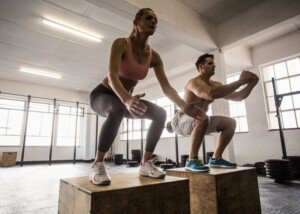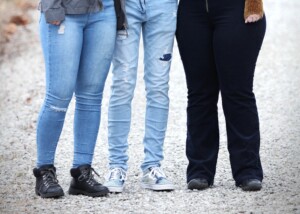Do you feel as though your bones are weak?
It’s never too late to build more strength in your bones. Bone health is often overlooked, but it’s very important.
Here are ways to increase the strength in your bones. No gimmicks. Nothing complicated.
Even if you’re over 65, you can still improve the strength of your bones.
Stronger Bones at Any Age
Weight bearing exercise is crucial because in order to move against resistance, muscles must contract.
Contracting muscles, which are attached to bones by tendons, pull on bones.
This pulling forces the bone to become stronger and denser, in “anticipation” for the next pulling (weight bearing) activity.
Some personal trainers have their older clients performing a lot of balancing during sessions.
Though balance exercises are important, they should not take priority over basic strength training (weight bearing) movements.
Problems with Balance Dominant Sessions
A few balance drills tossed into a weight workout are great, but a workout session for an older person should not be focused mostly on balance stunts.
Focusing on balance, before developing the more important strength training, will not deliver the goods.
For bone to become stronger it must be loaded along its length, such as when using a leg press machine or squats at home (squats can be modified to suit one’s fitness level).
A leg press or squat loads bone in a linear way, down the spine (squat), hips and legs.
This is especially true when weight is added to the squat – which can be done in many ways, such as holding a weight in one’s hands.
If meaningful squats are not possible due to a knee problem, it may still be possible to safely do the leg press, leg curl and leg extension.
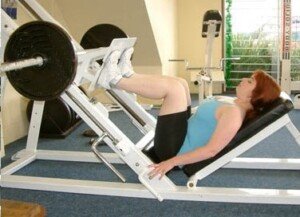
Leg press. George Stepanek, CreativeCommons
Your thighs do NOT need to be parallel to the floor to get a good training effect with a squat, but if you can painlessly go parallel, this is recommended, as this position recruits greater muscle fiber – and hence, yields greater load on the femur and hip bones to make them stronger.
More Examples of Strength Training for Stronger Bones Are Shown Below
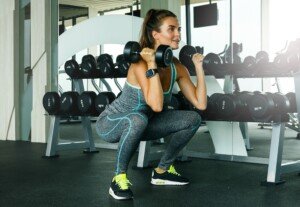
Dumbbell squat. Shutterstock/BLACKDAY
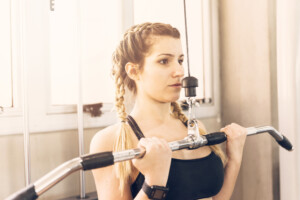
Narrow grip pull-down. Freepik.com
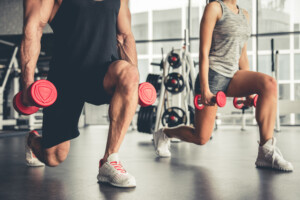
Dumbbell lunge. Shutterstock/VGstockstudio
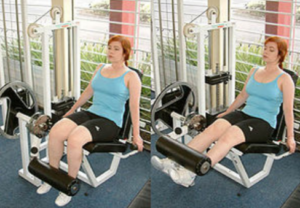
Leg extension. George Stepanek
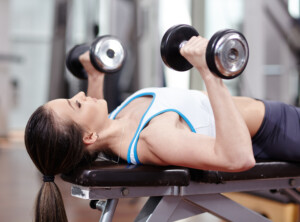
Dumbbell press
Velocity Training
This is reaction-speed training.
When an older person falls and breaks a hip, this does not happen in slow motion.
The person needs to react fast enough to intercept the fall – but if the fall is not stopped, the person needs strong bones to prevent a fracture.
You can use light weights for velocity routines, as long as the repetitions are done quickly and with good form.
A great velocity exercise is to sit on a stable bench or chair (hips above the knees), holding light weights, and standing up as fast as possible. Repeat eight times, working your way up to 20 reps.
Plyometrics
This means jumping exercises – but not jumping jacks or jump rope, which are endurance based.
For stronger bones you need power based jumping.
A beginner or “out of shape” person may find they have zero endurance for jumping rope and jumping jacks.
But there’s good news: Building strength and power does not require endurance exercise.
Plyometrics refers specifically to the type of jumping exercise that can’t be sustained, such as jumping onto a 12-inch exercise stool, then jumping off.
You do not have to immediately repeat. You can take 20 or 30 seconds in between jumps, but make sure that every single jump is your best effort.
What if you feel too weak to jump?
Simply rise up onto your toes and then let your body weight fall back down so that the heel strikes the floor.
Essentially this is a calf raise. To a de-conditioned person, this seemingly simple movement will have a training effect and prepare the body for more forces later.
The next phase is to step up and down on a 12-inch stool. If this is too difficult, a bottom staircase step can be used.

Freepik.com
This second phase has the element of balance and coordination. The goal is to do the stepping without holding onto anything.
Once phase II is mastered (you’ve worked your way up to a 12-inch height, give or take), you’re ready for actual jumping.
But start slightly, even if only a few inches off the floor. Over time, increase your airborne height.
Do eight to 12 repetitions for all three phases, focusing on power. It’s better to do eight of your highest jumps onto the stool or box, with half a minute or even a minute in between, rather than eight rushed, sloppy jumps that are not at your peak height.
If you’ve been diagnosed with osteoporosis or a spinal issue, you’ll need to get clearance from your physician for any kind of jumping exercise.
Frequency of Exercise
Twice a week is all you need for each type of exercise. You can combine a few types per session.
Just 20 minutes per session will be sufficient to transform a feeling of having weak bones to a feeling and reality of having much stronger bones.
 Lorra Garrick has been covering medical, fitness and cybersecurity topics for many years, having written thousands of articles for print magazines and websites, including as a ghostwriter. She’s also a former ACE-certified personal trainer for Bally Total Fitness.
Lorra Garrick has been covering medical, fitness and cybersecurity topics for many years, having written thousands of articles for print magazines and websites, including as a ghostwriter. She’s also a former ACE-certified personal trainer for Bally Total Fitness.
.


